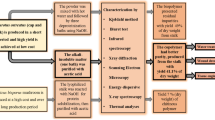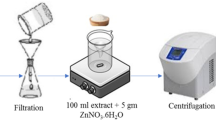Abstract
The fungus, Colletotrichum gloeosporioides, which is pathogenic to peppers produced an extracellular polysaccharide in liquid culture which possessed clay-dispersing activity. The polysaccharide could bind cationic dyes, Ruthenium Red and Alcian Blue, indicating it to be polyanionic. The polysaccharide dispersed kaolin in water and the dispersion was maintained for more than 7 days at 25 °C. Kaolin dispersion by the polysaccharide was stable from pH 3 to 10 but the addition of divalent metals at 1 mM inhibited half of the dispersion activity comparing to the control. The polysaccharide could disperse bentonite, calcium carbonate and other fine particles but did not possess emulsifying activity.
Similar content being viewed by others
References
Bar-Or Y,Shilo M (1987) Characterization of macromolecular flocculants produced by Phormidium sp. strain J-1 and by Anabaenopssis circularis PCC6720. Appl. Environ. Microbiol. 53: 2226-2230.
Bradford MM (1976) A rapid and sensitive method for the quantifi-cation of microgram quantities of protein utilizing the principle of protein-dye binding. Anal. Biochem. 72: 248-254.
Carlson DM,Mathews LW (1966) Polymeric acids produced by Pseudomonas aeruginosa. Biochemistry 5: 2817-2822.
Choi CW,Yoo SA,Oh IH,Park SH (1998) Characterization of an extracellular flocculating substance produced by a planktonic cyanobacterium, Anabaena sp. Biotechnol. Lett. 20: 643-646.
Cirigliano MC,Carman GM (1984) Isolation of a bioemulsifier from Candida lipolytica. Appl. Environ. Microbiol. 46: 747-750.
Dubois M.,Gilles KA,Hamilton JK,Rebers PA,Smith F (1956) Colorimetric method for determination of sugars and related substances. Anal. Chem. 28: 349-356.
Hoffman EM,Bauknecht N (1999) A dye binding assay for the quantification of soluble and cell-bound acidic polysaccharides produced by red algae. Anal. Biochem. 267: 245-251.
Hwang SS (2000) Pathogenicity, cultural characteristics, and genetic variation of Colletotrichum gloeosporioides causing pepper anthracnose. M.S. Thesis, Pai Chai University, Korea.
Rosenberg E,Rubinovitz C,Gottlieb A,Rosenhak S,Ron EZ (1988) Production of biodispersan by Acinetobacter cacoaceticus A2. Appl. Environ. Microbiol. 54: 317-322.
Sloneker JH,Jeanes A (1962) Exocellular bacterial polysaccharide from Xanthomonas campestris NRRL B-1459. Part I. Constitution. Can. J. Chem. 40: 2066-2071.
Sutherland W (1998) Novel and established application of microbial polysaccharides. Trend Biotechnol. 16: 41-47.
Author information
Authors and Affiliations
Rights and permissions
About this article
Cite this article
Park, S.H., Choi, C.W., Shim, M.Y. et al. Isolation and characterization of a clay-dispersing polysaccharide produced by the phytopathogenic fungus, Colletotrichum gloeosporioides. Biotechnology Letters 23, 1719–1722 (2001). https://doi.org/10.1023/A:1012477004056
Issue Date:
DOI: https://doi.org/10.1023/A:1012477004056




